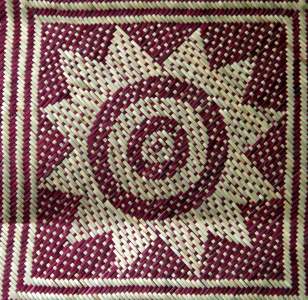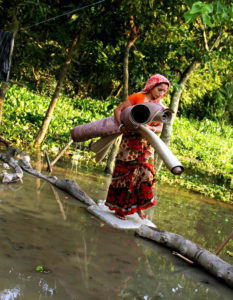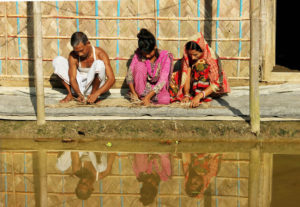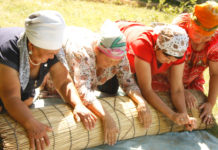Woven and plaited natural fibres like cane, bamboo, reeds and grass have been used from earliest times to fulfil mankind’s basic needs. In Bangladesh they are used for thatched homes and a range of storage baskets to mats, fish traps and a variety of other products. Being a deltaic region, renewable fibres like cane, bamboo, a variety of reeds and grasses are readily available and widely used in Bangladesh. From homes with thatched roofs to decorative room dividers, doors and windows to intricately woven mats and basketry, these products are as aesthetically pleasing as they are invaluable to our everyday life.
Along with a multitude of shapes and sizes, fibre products are woven in perfectly harmonised range of floral, linear and geometric patterns, in plant dyes of maroon and navy or by smoking the fibres into darker shades for designs. Apart from mats and basketry some of the more popular cane, bamboo and grass articles are hand-fans, fish traps, poultry pens, baby cots and a variety of home products. Contemporary products include lamps, shades, trays and an extensive range of garden furniture. Coiled basketry has the closest affinity to weaving, with ethnic communities, often replicating their textiles patterns in their unique basketry.
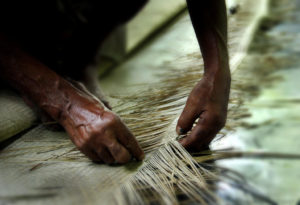 Amongst Bangladesh’s fibre crafts the most ubiquitous are the mats. Apart from the everyday chatai and madur mats some areas have their own special designs and techniques. From Noakhali come the Botni prayer mats in combinations of natural and dark blue; made by women for the family and honoured guests, they are woven on the diagonal with patterns being synchronised with the mihrab often being embellished with stylised forms of everyday articles, flowers and plants from the women’s world. Words and verses, expressing affection, are sometimes woven into these mats. The Faridpur mats are highly valued for being soft and pliable enough for a full sized mat to be folded into a small, portable packet.
Amongst Bangladesh’s fibre crafts the most ubiquitous are the mats. Apart from the everyday chatai and madur mats some areas have their own special designs and techniques. From Noakhali come the Botni prayer mats in combinations of natural and dark blue; made by women for the family and honoured guests, they are woven on the diagonal with patterns being synchronised with the mihrab often being embellished with stylised forms of everyday articles, flowers and plants from the women’s world. Words and verses, expressing affection, are sometimes woven into these mats. The Faridpur mats are highly valued for being soft and pliable enough for a full sized mat to be folded into a small, portable packet.
sitalpati of Sylhet, in north Bangladesh. Woven in soft, finely sliced indigenous reed, the natural golden warp is interwoven with maroon or navy slips in the weft to create the enchanting sitalpati. It is embellished with intricate floral and geometric border design; the central section is sometimes divided into four or six sections to depict flowers, plants, deer and tigers. The sitalpati, made of the softest material, is also very light and easily foldable for storage and travel.
Mats and basketry are an integral part of everyday life in rural and urban Bangladesh.


